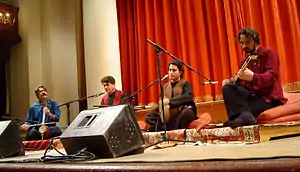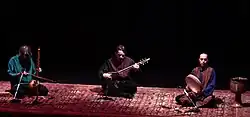Masters of Persian Music | |
|---|---|
 Original ensemble members (from left) K. Kalhor, Mohammad-Reza Shajarian, H. Shajarian, and H. Alizâdeh | |
| Background information | |
| Origin | Iran |
| Genres | Persian classical music |
| Labels |
|
Masters of Persian Music is a Persian classical music ensemble (or "supergroup") founded in 2000 by four internationally recognized ustāds (masters) of the genre: vocalist Mohammad-Reza Shajarian; composer-musicians Hossein Alizâdeh and Kayhan Kalhor; and Mr. Shajarian's son, multi-instrumentalist singer Homayoun Shajarian.[1]
The ensemble formed with a view to touring Europe and North America (where Kayhan Kalhor has lived for much of his adult life). Although not all of the four had collaborated previously,[2] Mr. Shajarian had worked with Kalhor and Alizâdeh. In 1998 he sang for a studio album called Night, Silence, Desert,[3] which Kalhor produced. He also sang the score that Alizâdeh composed for Ali Hatami's historical drama Del Shodegan (1992).[4] Both albums were published on Delawaz Records,[5] a label Shajarian started for the preservation of Persian classical singing.[6]
Performances
Kalhor saw the group as cultural ambassadors.[2] They adopted the name Masters of Persian Music for touring abroad. (In Iran, they used to perform and record under their own names.) The first European tour began in 2000, followed by a voyage to North America in early 2001.[7][8] However, due to visa difficulties, Alizâdeh missed the first nine of the 18 performances in North America, and the other members had to play without him.[9] Nevertheless, the success of the tour led to another in 2002 (organized by the World Music Institute), and a third in 2005.[10][11] During this period, they released three live albums: Zemestan ast ("It's Winter") in 2001, Bi to be sar nemishavad ("Without You") in 2002, and the double album Faryad ("The Cry") in 2003.[1][12]
It's Winter (Persian: زمستان است) is a recording of the ensemble's first concert in California in 2001. The second album, Without You, was a nominee for the Grammy Award for Best Traditional World Music Album in the 46th Annual Grammy Awards.[13] Faryad, recorded on a later tour, was nominated in 2005.[12][14] 2005 also saw the release of Hamnava ba Bam, a DVD video of the ensemble's 2003 memorial and benefit concert in Tehran, which raised relief funds for survivors of the 2003 Bam earthquake.[15][16] In 2007, Delawaz Records published the ensemble's two final live albums: Saz-e-khamoush (Persian: ساز خاموش) and Soroode-e-mehr (Persian: سرود مهر "October Song").[5][17] Between the concert tours, the members also continued to perform and record with other artists.

Hossein Alizâdeh and Kayhan Kalhor toured Europe and North America again in 2010. In Europe they were accompanied by tonbak player Majid Khalaj, but for the North American tour they enlisted the support of five younger musicians; promoters billed them as "Masters of Persian Music: Three Generations". This expanded ensemble included Hamid Reza Nourbakhsh (voice), Fariborz Azizi (bass tar), Siamak Jahangiry (ney), Pezhham Akhavass (tonbak), and Rouzbeh Rahimi (santur).[1][18] Kalhor saw a need to reach out to younger Iranian musicians, since the Iranian Revolution of 1979 created a "generational divide" by widely barring music practice and performance—thus driving many musicians of the older generation out of the country.[10][19] But the original lineup is also multi-generational: In 2005, M. R. Shajarian was age 62, Alizadeh 52, Kalhor 40, and H. Shajarian 28. Kalhor says that Iranians see the group as a symbol of continuity in the culture's traditions.[2]
Tours of North America
The ensemble has visited at least 18 cities in the United States and Canada:
| Country | City | Tour year | |||
|---|---|---|---|---|---|
| 2001 | 2002 | 2005 | 2010 | ||
| Canada | Toronto, Ontario | ? | ? | 18 February[20] | 5 February[21] |
| Vancouver, British Columbia | ? | date missing[9] | 20 February[20] | ? | |
| United States | Atlanta, Georgia | ? | ? | 10 March[20][22] | 26 February[23] |
| Austin, Texas | ? | 18 October[9] | ? | ? | |
| Berkeley, California | 10 February[24] | ? | 27 February[2] | 13 February[25] | |
| Boston, Massachusetts | 4 March[24] | date missing[11] | 12 March[20][22] | 19 February[23] | |
| Chicago, Illinois | ? | ? | 20 March[20][22] | 23 February[23] | |
| Cleveland, Ohio | ? | date missing[9] | 18 March[20][22] | 20 February[23] | |
| Durham, North Carolina | 2 March[26] | 11 October[11] | ? | ? | |
| Honolulu, Hawaii | ? | ? | 1 March[20][22] | ? | |
| 2 March[20][22] | |||||
| Irvine, California | ? | ? | ? | 12 February[27] | |
| Ithaca, New York | ? | date missing[28] | ? | ? | |
| Los Angeles, California | ? | ? | 26 February[20] | 10 February[27][29] | |
| New York, New York | 24 February[24] | date missing[11] | 6 March[20][22] | 18 February[23] | |
| 13 March[20][22] | |||||
| Portland, Oregon | 9 February[24] | ? | ? | ? | |
| San Francisco, California | ? | date missing[11] | — | ? | |
| Saratoga, California | ? | ? | 24 February[20] | 14 February[25] | |
| Washington, D.C. | 25 February[24] | ? | 5 March[20][22] | 28 February[23] | |
See also
References
- 1 2 3 Beres, Derek (23 April 2010). "Masters of Persian Music Again Evolve Iran". The Huffington Post. Retrieved 21 January 2015.
- 1 2 3 4 Curiel, Jonathan (27 February 2005). "Poetry from Persia". SFGate. Retrieved 21 January 2015.
- ↑ Night, Silence, Desert at Discogs
- ↑ Delshodegan at Discogs
- 1 2 "Discography § Ensemble". HosseinAlizadeh.net. Retrieved 22 January 2015.
- ↑ "تاریخچه و اهداف" [History]. Delawaz.com (in Persian). Archived from the original on 13 May 2008. Retrieved 21 January 2015.
- ↑ "Kayhan Kalhor". The Iranian. Abadan Publishing Co. Retrieved 4 February 2016.
- ↑ Ostovany, Yari (27 October 2000). "Shajarians Carry the Night". The Iranian. Abadan Publishing Co. Retrieved 4 February 2016.
- 1 2 3 4 Kalhor, Kayhan (17 October 2002). "Masters of Persian Music". All Things Considered (Interview). Interviewed by Jacki Lyden. Retrieved 21 January 2015.
- 1 2 Kalhor, Kayhan; Shajarian, Mohammad-Reza (21 March 2005). "The Masters of Persian Music Tour the U.S." Morning Edition (Interview). Interviewed by Renée Montagne. Culver City. Retrieved 21 January 2015.
- 1 2 3 4 5 "Masters of Classical Persian Music: On Tour". FarsiNet. FarsiNet, Inc. 2002. Retrieved 21 January 2015.
- 1 2 Tsioulcas, Anastasia (5 March 2005). "Billboard Picks: Albums § Faryad". Billboard. Prometheus Global Media: 40–41. Retrieved 21 January 2015.
- ↑ "Complete list of Grammy Award nominations". East Valley Tribune. 4 December 2003. Retrieved 11 July 2011.
- ↑ Staff writer (9 December 2005). "The Complete List of Grammy Nominations". The New York Times. Retrieved 21 January 2015.
- ↑ "Masters of Persian Music". Cindy Byram PR. Retrieved 21 January 2015.
- ↑ "استاد محمد رضا شجریان" [Mohammad-Reza Shajarian]. Delawaz.ir (in Persian). 20 January 2015. Retrieved 22 January 2015.
- ↑ Jurek, Thom. "Artist Biography: Kayhan Kalhor". Allmusic. All Media Network. Retrieved 22 January 2015.
- ↑ "Masters of Persian Music: Three Generations". opus3artists.com. Opus 3 Artists. Retrieved 21 January 2015.
- ↑ Gilbert, Andrew (19 February 2010). "Rebuilding music in Iran: Masters turn to new generation". Boston.com. Boston Globe Media Partners. Archived from the original on 1 January 2011. Retrieved 21 January 2015. Alt URL
- 1 2 3 4 5 6 7 8 9 10 11 12 13 "Masters of Classical Persian Music". FarsiNet. FarsiNet, Inc. Retrieved 21 January 2015.
- ↑ Benes, Derek (19 February 2010). "Masters of Persian Music on 'Three Generations' Tour". SHOUTcast Radio Blog. AOL. Archived from the original on 30 December 2010. Retrieved 21 January 2015.
- 1 2 3 4 5 6 7 8 9 Staff writer (October 2004). "Masters of Persian Classical Music: North American Tour - February/March 2005". The Iranian. Iranian Ltd. Retrieved 21 January 2015.
- 1 2 3 4 5 6 Staff writer (19 February 2010). "Concert Review: Masters of Persian Music in NYC 2/18/10". Lucid Culture. Retrieved 21 January 2015.
- 1 2 3 4 5 Staff writer (7 February 2001). "International Beat: Ry Cooder, Masters of Persian Music, Lunasa". MTV News. Viacom International. Retrieved 21 January 2015.
- 1 2 Gilbert, Andrew (11 February 2010). "Masters of Persian music". San Jose Mercury News. Retrieved 21 January 2015.
- ↑ "Masters of Classical Persian Music: North American Tour, January–March 2001". FarsiNet. FarsiNet, Inc. 2001. Retrieved 21 January 2015.
- 1 2 Heckman, Don (13 July 2012). "Picks of the Week: Feb. 8–14". The International Review of Music. Retrieved 21 January 2015.
- ↑ Staff writer. "Past Highlights". Cornell Concert Series. Cornell University. Retrieved 21 January 2015.
- ↑ "Virtuosic Masters of Persian Music Weaves Contemporary Element into Ancient Persian Classical Music in Rare U.S. Appearance at Walt Disney Concert Hall". Pars Times. 2005. Retrieved 21 January 2015.
External links
- Masters of Persian Music at AllMusic
- Masters of Persian Music discography at Discogs
- Masters of Persian Music at Last.fm
- Masters of Persian Music at Philpedia
Further reading
- Klaser, Rajna (11 February 2001). "World Music Review: Master of Persian Classical Music". San Francisco Classical Voice. Retrieved 21 January 2015.
- Denis, Par Jacques (20 October 2011). "En Iran, voyage dans la machine à remonter le temps". Le Monde (in French). Retrieved 21 January 2015.